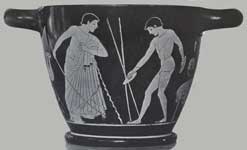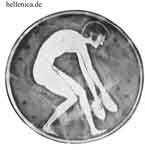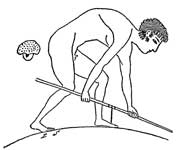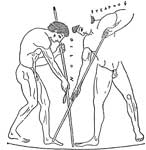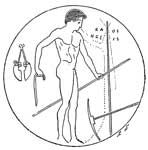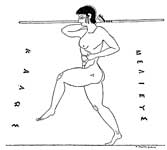.
Parts: 1 - 2 - 3 - 4 - 5 - 6 -
 |
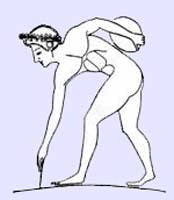 Discobolos, marking the take-off, Kylix, Antikenkabinett, Würzburg, No. 357 |
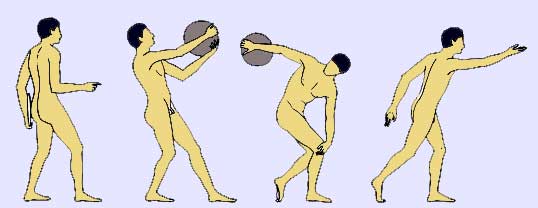
- Discus (δίσκος, diskos – diskobolos) (around 6 kg weight three times heavier than the modern discus). Material changed from stone to bronze. In Odyssey Homer describes the use of stones (Odyssey Book 8)
Odysseus finished and then, still wrapped up in his cloak,
picked up a hefty discus, bigger than the others,
much heavier than the ones used by Phaeacians
when they competed with each other. With a whirl,
he sent it flying from his powerful hand.
The stone made a humming sound as it flew along,
and the long-oared Phaeacians, men who love their ships,
ducked down near the ground, below that flying stone.
It sailed beyond the marks of all the other men,
speeding lightly from his hand, and Athena,
in the likeness of a man, marked where it fell.
There are various theories how this game developed. For example it is possible that it developed just from stone throwing used for hunting or as a weapon against enemies. Discus throwing as a game (funeral) is mentioned in Homer's Iliad Book 23:
Then Peleus' son [Achilles ] put out a lump of rough-cast iron,
which, in earlier days, Eëtion had used for throwing.
Godlike, swift-footed Achilles had slaughtered him,
then taken his iron and all his other goods
away in his swift ship.
... Then up came Polypoetes,
a strong fighter, and godlike Leonteus,
a powerful man, then Telamonian Ajax,
and godlike Epeius. They stood there in a line.
Godlike Epeius gripped the weight, swung it round,
then threw. The Achaeans all laughed at the result.
The second one to throw was Leonteus,
offshoot of Ares. Great Ajax, son of Telamon,
was third to throw. His strong hand tossed the weight,
hurling it beyond the marks of all the others.
But then that strong warrior Polypoetes
picked up the weight and threw it even further
than all those in the contest, by the same distance
a herdsman throws his staff, so it flies spinning
in among his cattle herd. The crowd all shouted .
The comment that Eetion used to throw a discus taken by Achilles suggests that the game was imported from Asia.
The laws of Olympia were written on a discus in the Hera temple. Probably very similar movements like in modern discus events (except the multiple rotation as discus results of 30 meter were reported but details are not known) . ( The Discobolus ) A known statue is the Discus thrower of Myron with its original destroyed but many copies of it exist. In Greek Mythology there are various stories of persons killed accidentally (or not)by the discus. Perseus participating in some funeral games in Lariss accidentally threw a discus at Acrisius, killing him . Hyacinthus and Crocus were accidentaly killed by a discus thrown by Apollo and Hermes respectively. Plutarch in Lycurgus describes discus throwing by women in Sparta. In Greek mythology Orion is killed by Artemis by a discus. Replica of a discus dedicated to Zeus in Olympia





Halteres, Stone and metal , British and Berlin Museums
- Long jump (alma (άλμα) – the jumper: o pidon),
Holding a weight (halter, pl. halteres) of around 2 kg (or even more) in each hand (actually a multiple jump, maybe 5 times as jump length of up to 16 meters were reported). Coordination was accomplished by music (rythms) played by a flute player. THE HALTERES-JUMP
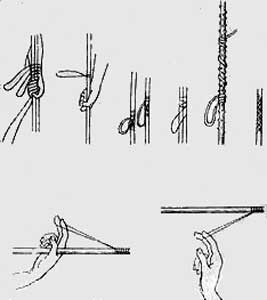
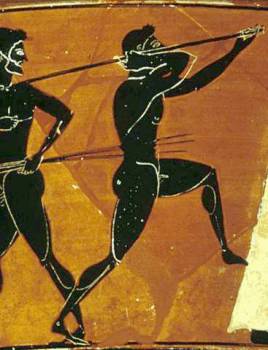
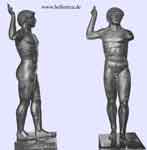
Bronze Archaic Sculpture Louvre
- Javelin throw (akon (ακόν)- akontistis) A leather strap was fixed to the shaft of the javelin to form a loop (αγκύλη). When throwing, the athlete inserted his index and second fingers into the loop allowing to increase the distance the javelin was thrown.Versions: ekivolos ( &epsilonκήβολος) distance throw and stohastikos (στοχαστικός) thwrowing to a target.. According to Seneca in Phaedra not even the Cretans were able to shoot their arrows at a larger distance than the pentathlets (which would suggest a distance of around 200 m!)
- Foot race (dromos - stadiodromos)
1 Stadium distance - Wrestling (pali - palaistis).
- Horse and Chariot games since 680 BC (first winner Pagon of Thebes).
Biga and Quadriga races with 2 horses (Synoris (συνωρίς ) and with 4 horses ( Tethrippon) (τέθριππο ) respectively. Performed not by horse holder but specialists (sometimes women were the holders of the horses). , Chariot Racing ,From 500-444 BC also Mule races (apene) (απήνη)
The Iliad describes a chariot race held for Patroclos Iliad 23
Herodotus calls a wealthy family a tetrippotrophon (able to maintain four horses for a race)
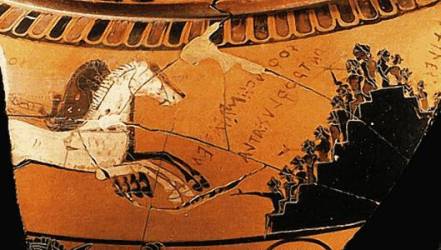
Horse Race help for Patroclus from a piece of pottery 580 – 570 BC (Sophilos).

Hitherto the ill-fated Orestes had passed safely through every round, steadfast in his steadfast car; at last, slackening his left rein while the horse was turning, unawares he struck the edge of the pillar; he broke the axle-box in twain; he was thrown over the chariot-rail; he was caught in the shapely reins; and, as he fell on the ground, his colts were scattered into the middle of the course. But when the people saw him fallen from the car, a cry of pity went up for the youth, who had done such deeds and was meeting such a doom,- now dashed to earth, now tossed feet uppermost to the sky,- till the charioteers, with difficulty checking the career of his horses, loosed him, so covered with blood that no friend who saw it would have known the hapless corpse. Straightway they burned it on a pyre; and chosen men of Phocis are bringing in a small urn of bronze the sad dust of that mighty form, to find due burial in his fatherland. Sophocles Electra
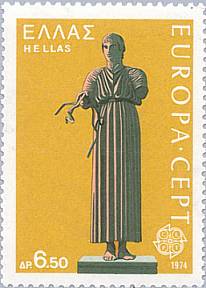
The Charioteer of Delphi and details of his Chiton, a version called xystis used by all chariot drivers during the race. It spans the whole body all the way to his ankles. It is fastened high at the waist with a plain belt. Two straps cross high at his upper back and round his shoulders keep the chiton fixed during the race.
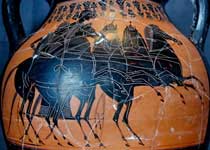
| Ancient Greece
Science, Technology , Medicine , Warfare, , Biographies , Life , Cities/Places/Maps , Arts , Literature , Philosophy ,Olympics, Mythology , History , Images Medieval Greece / Byzantine Empire Science, Technology, Arts, , Warfare , Literature, Biographies, Icons, History Modern Greece Cities, Islands, Regions, Fauna/Flora ,Biographies , History , Warfare, Science/Technology, Literature, Music , Arts , Film/Actors , Sport , Fashion --- |




